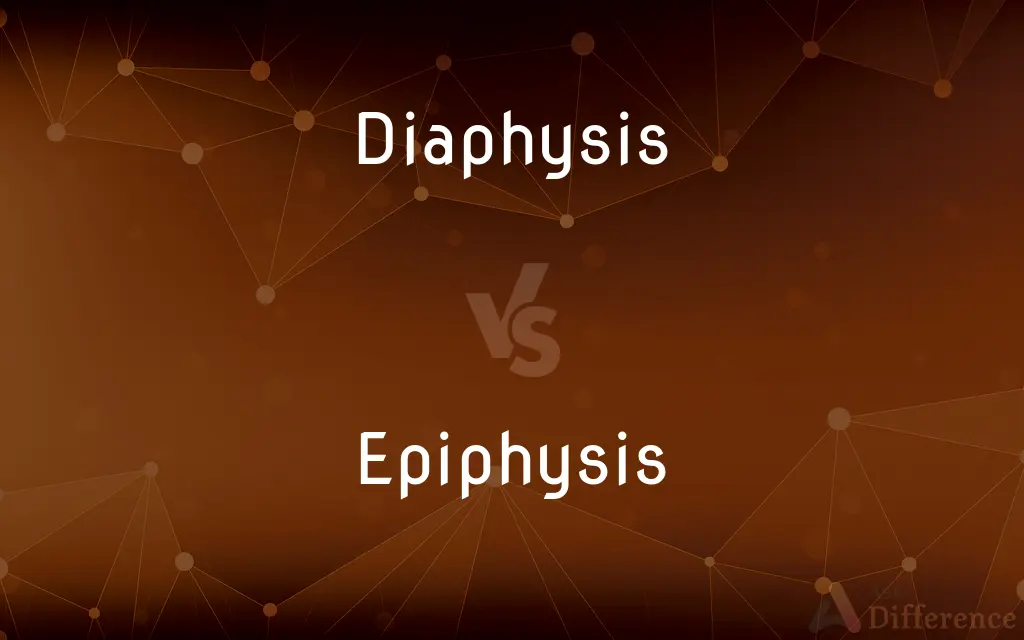Diaphysis vs. Epiphysis — What's the Difference?
Edited by Tayyaba Rehman — By Fiza Rafique — Updated on November 1, 2023
Diaphysis refers to the main or midsection (shaft) of a long bone, while epiphysis refers to the end parts of a long bone, initially growing separately from the shaft.

Difference Between Diaphysis and Epiphysis
Table of Contents
ADVERTISEMENT
Key Differences
The diaphysis is the central shaft of a long bone and is primarily composed of compact bone which provides strength. The epiphysis is found at the ends of a long bone, consists of spongy bone, and provides attachments for muscles and stability to joints.
Bone growth in length occurs at the epiphyseal plate, a layer of hyaline cartilage where new bone is formed. The diaphysis, once fully formed, does not contribute to bone lengthening; its growth in width is due to the activity of the periosteum.
In the diaphysis, the marrow cavity is a significant feature that houses bone marrow, which is involved in the production of blood cells. The epiphysis is typically filled with spongy bone and red marrow, playing a crucial role in blood cell production during childhood.
Fractures involving the diaphysis are often treated by setting the bone and ensuring alignment for proper healing. Epiphyseal fractures can be more complex if they involve the growth plate and may affect the future growth of the bone.
The epiphysis is typically covered with articular cartilage in areas where the bone forms a joint with another bone, aiding in smooth movement. The diaphysis does not have this feature as it is not directly involved in joint formation.
ADVERTISEMENT
Comparison Chart
Location
Shaft or midsection of a long bone.
Ends of a long bone.
Composition
Mostly made up of compact bone.
Composed mainly of spongy bone.
Function
Provides strength and supports weight.
Facilitates joint movement and muscle attachment.
Growth
Does not contribute to bone lengthening post-adolescence.
Contains growth plates in children and adolescents.
Marrow Cavity
Contains bone marrow involved in blood cell production.
Often contains red marrow in children for blood formation.
Compare with Definitions
Diaphysis
Made predominantly of compact bone.
Bone density tests measure the compact bone in the diaphysis.
Epiphysis
The end part of a long bone, initially growing separately.
The epiphysis is crucial for joint movement.
Diaphysis
He central, long shaft of a long bone.
The fracture was located in the diaphysis of the femur.
Epiphysis
Provides sites for muscle attachment.
Tendons connect to the epiphysis of long bones.
Diaphysis
The diaphysis is the main or midsection (shaft) of a long bone. It is made up of cortical bone and usually contains bone marrow and adipose tissue (fat).
Epiphysis
Comprised mostly of spongy bone.
Spongy bone in the epiphysis absorbs impact on joints.
Diaphysis
The shaft of a long bone.
Epiphysis
Often involved in epiphyseal fractures.
The skateboarder suffered an epiphyseal fracture in his wrist.
Diaphysis
(anatomy) The central shaft of any long bone.
Epiphysis
The epiphysis is the rounded end of a long bone, at its joint with adjacent bone(s). Between the epiphysis and diaphysis (the long midsection of the long bone) lies the metaphysis, including the epiphyseal plate (growth plate).
Diaphysis
(botany) An abnormal elongation of the axis of a flower or of an inflorescence.
Epiphysis
The end of a long bone that is originally separated from the main bone by a layer of cartilage but later becomes united to the main bone through ossification.
Diaphysis
An abnormal prolongation of the axis of inflorescence.
Epiphysis
See pineal gland.
Diaphysis
The shaft, or main part, of a bone, which is first ossified.
Epiphysis
(anatomy) The pineal gland.
Diaphysis
The main (mid) section of a long bone
Epiphysis
(skeleton) The rounded end of any long bone.
Diaphysis
Encloses the bone marrow cavity.
The diaphysis' marrow cavity is the site of blood cell production.
Epiphysis
(zoology) A small upper piece of each half of an alveolus of a sea urchin.
Diaphysis
Mainly responsible for the bone's length.
During growth, the diaphysis elongates before the epiphyses are fused.
Epiphysis
The end, or other superficial part, of a bone, which ossifies separately from the central portion, or diaphysis.
Diaphysis
Subject to shaft fractures.
Diaphysis fractures are common in sports injuries.
Epiphysis
The end of a long bone; initially separated from the main bone by a layer of cartilage that eventually ossifies so the parts become fused
Epiphysis
A small endocrine gland in the brain; situated beneath the back part of the corpus callosum; secretes melatonin
Epiphysis
Includes the growth plate in young individuals.
The doctor checked the epiphysis to ensure the growth plate was not damaged.
Common Curiosities
Does the epiphysis contain a growth plate?
Yes, in children and adolescents, the epiphysis contains a growth plate.
What material predominantly makes up the diaphysis?
The diaphysis is predominantly made of compact bone.
What is the epiphysis?
The epiphysis refers to the ends of a long bone.
What is the diaphysis?
The diaphysis is the shaft or middle section of a long bone.
What kind of marrow is found in the diaphysis?
The diaphysis typically contains yellow bone marrow in adults.
Does the epiphysis contribute to the length of bones?
Yes, the epiphysis contributes to bone length during development.
Are diaphysis fractures common?
Yes, they can be common due to impacts and stresses on the bone.
What is the role of the epiphysis in joint formation?
The epiphysis forms the part of the bone that articulates with other bones to form a joint.
What is the significance of an epiphyseal line?
It is the remnant of the growth plate, indicating that bone growth in length has ceased.
At what age does the epiphysis fuse with the diaphysis?
Fusion typically occurs after puberty, around 18-25 years of age.
Can the diaphysis grow in width?
Yes, it can grow in width due to the activity of the periosteum.
Is the bone marrow in the diaphysis the same throughout life?
No, it transitions from red to yellow marrow as a person matures.
Can an x-ray distinguish between the diaphysis and epiphysis?
Yes, an x-ray can typically show the difference due to varying densities and structures.
Can diseases affect the diaphysis and epiphysis differently?
Yes, certain conditions may preferentially affect one over the other.
How are diaphysis and epiphysis injuries treated?
Treatment depends on the specific injury but may include immobilization or surgery.
Share Your Discovery

Previous Comparison
Telly vs. Belly
Next Comparison
Impala vs. DeerAuthor Spotlight
Written by
Fiza RafiqueFiza Rafique is a skilled content writer at AskDifference.com, where she meticulously refines and enhances written pieces. Drawing from her vast editorial expertise, Fiza ensures clarity, accuracy, and precision in every article. Passionate about language, she continually seeks to elevate the quality of content for readers worldwide.
Edited by
Tayyaba RehmanTayyaba Rehman is a distinguished writer, currently serving as a primary contributor to askdifference.com. As a researcher in semantics and etymology, Tayyaba's passion for the complexity of languages and their distinctions has found a perfect home on the platform. Tayyaba delves into the intricacies of language, distinguishing between commonly confused words and phrases, thereby providing clarity for readers worldwide.
















































